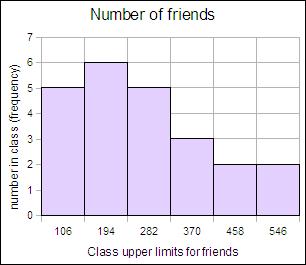| MySpace |
1 |
level |
ratio |
ordinal accepted |
| 18 |
2 |
n |
23 |
ratio level more appropriate |
| 18 |
3 |
min |
18 |
see below |
| 20 |
4 |
max |
546 |
|
| 30 |
5 |
range |
528 |
|
| 35 |
|
classes |
6 |
|
| 118 |
6 |
width |
88 |
|
| 119 |
|
CUL |
Freq |
RF |
| 123 |
7 |
106 |
5 |
0.22 |
| 149 |
|
194 |
6 |
0.26 |
| 160 |
|
282 |
5 |
0.22 |
| 167 |
|
370 |
3 |
0.13 |
| 200 |
|
458 |
2 |
0.09 |
| 200 |
|
546 |
2 |
0.09 |
| 200 |
|
|
23 |
1 |
| 208 |
8 |
|
|
|
| 209 |
9 |
skewed right |
|
|
| 300 |

|
| 300 |
| 306 |
| 400 |
| 400 |
| 500 |
| 546 |
|
|
|
|
|
|
|
| If you have more than five unique numbers, numeric data points, |
|
|
|
|
| then you likely have data that can be treated as ratio level data. |
|
|
|
|
| If the data has decimals or fractional values, then it is certainly ratio level data |
|
|
|
|
| even if the number of values is less than five. |
|
|
|
|
| Ultimately one can ask, "Does the average have a meaningful meaning?" |
|
|
|
|
| If the average (the mean) has "meaning" then the data can be treated as ratio |
|
|
|
|
| level data. |
|
|
|
|
| The above data has some 528 possible values between min and max, continuous |
|
|
|
|
| and ratio level for all intents and purposes. |
|
|
|
|

